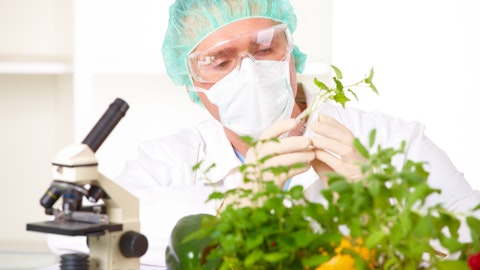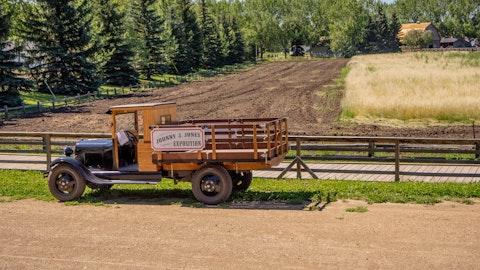Brian Cook: Yes. I think it’s really kind of playing into what CEA is all about. We are obviously a little bit more of an expensive price point that you’ve seen on shelf historically. But what it’s done is it’s really much €“ pretty much made that gap a lot smaller when it comes to what a retailer would see and a consumer would purchase at shelf. And that’s always a good thing, right, because at that point, the CEA space has the additional surety of supply; the ability to expand our Stack & Flow Technology allows us to do that in a far better way from a standpoint of capital expenditures and the ability to grow more with less. So this is really playing into Local Bounti’s hands in many ways, and we expect to see more and more room on the shelf with our €“ with our Local Bounti products moving forward.
Ben Klieve: Got it. Very helpful. Thanks for taking my questions and we’ll go back in line.
Jeff Sonnek: Hey Ben, thank you. Appreciate it.
Operator: Our next question is from the line of Kristen Owen with Oppenheimer. Please proceed with your questions.
Kristen Owen: Hi. Thanks. Good morning. I appreciate that you want to give some additional color on timing of that, that path to positive EBITDA and free cash flow on the next call. But I’m wondering if you can help maybe give a little preview to the movie or talk us through maybe on a facility basis what that path looks like for Hamilton, given that that’s your most mature facility? And how we think about sort of the timing of each of these facilities as you try to get towards EBITDA positive?
Craig Hurlbert: Thanks for that question, Kristen. Kathy, why don’t you start with that one? I think that’s a good question for you to start with.
Kathleen Valiasek: Yes. Yes, sure. Thanks and thanks Kristen, for the question. What we’ll see in Montana as well as all of us anxiously awaiting for the Pasco, Washington Facility to be up and running. Currently, what we’re doing €“ what we’re running out of that facility is many, many SKUs, okay, to support the Northwest. And what €“ the second that the Pasco facility is up and running, we will switch out what the Montana facility is doing and bring it down to 1 or 2 SKUs. And so much quicker that will come to €“ that facility will come to profitability. The other facilities, Georgia is ramping incredibly well. As we’ve said on other calls, the facilities will be cash flow positive. That Georgia, like any facility when you get them up and running, it takes three to six months for them to start operating profitably. Those are my thoughts and comments. Brian? Travis?
Brian Cook: Well said.
Travis Joyner: Yes, I have no…
Kristen Owen: So then if we could talk a little bit about what sort of OpEx you need to support the ramp. You already commented on the R&D expectations for 2023, but just give us a sense of what kind of OpEx you need to support this ramp over, say 2023, 2024 when we get to a run rate revenue?
Kathleen Valiasek: Yes, sure. And Craig, I’m sorry, I keep on having in here. Yes. So from an OpEx standpoint, we will be relatively steady, I would say for where our run rate is at Q4 2022. The significant drop down will be the R&D.
Kristen Owen: Great. And if I could squeeze just one last one in. Craig, I think €“ or maybe it was Travis, you talked about institutionalizing some of the learning cycles, getting the IT in place to protect growth over time. I’m just wondering what your process for institutionalizing those learning cycle is? And how you view sort of that ramp or closing the gap from the 1.4 to 1.8 times that you’re seeing initially in Georgia to maybe 2 or more out of the future facilities? Thank you.
Craig Hurlbert: That is a great question. Travis?
Travis Joyner: Yes, really, really great question, actually. Yes, I think the right way to answer the beautiful thing about having a Stack phase is you’re able to have a high degree of control of the environment, no matter where you are, whether it be Washington, Montana, Texas, Georgia or Abu Dhabi, you’re able to really replicate the same recipes within our Stack phase as they then transition over to the greenhouse. So what we’re seeing in Georgia in really a very short period of time in September of 2022, we activated our first Stack Tower. And since then we’ve been executing on literally in the hundreds of recipes to optimize that transition from Stack, into the greenhouse, into the Flow phase. And so the great part about where we sit is the Georgia facility is really a carbon copy or I guess I should say the Texas and Washington facilities are pretty much a carbon copy of the Georgia facility.
So the work that we’re doing in Georgia right now is from the playbook from Montana and the playbook from Georgia is going to transition to both Texas and Washington and accelerate our learning’s and scaling.
Kristen Owen: Great. Thank you so much.
Jeff Sonnek: Kristen, thank you.
Operator: Thank you. The next question comes from the line of Pam Kaufman with Morgan Stanley. Please proceed with your question.
Jeff Drezner: This is Jeff Drezner on for Pam Kaufman. Just a quick question on CapEx and what you anticipate that spend to look like this year in support of the expansion projects?
Craig Hurlbert: Kathy, why don’t you take that one?

